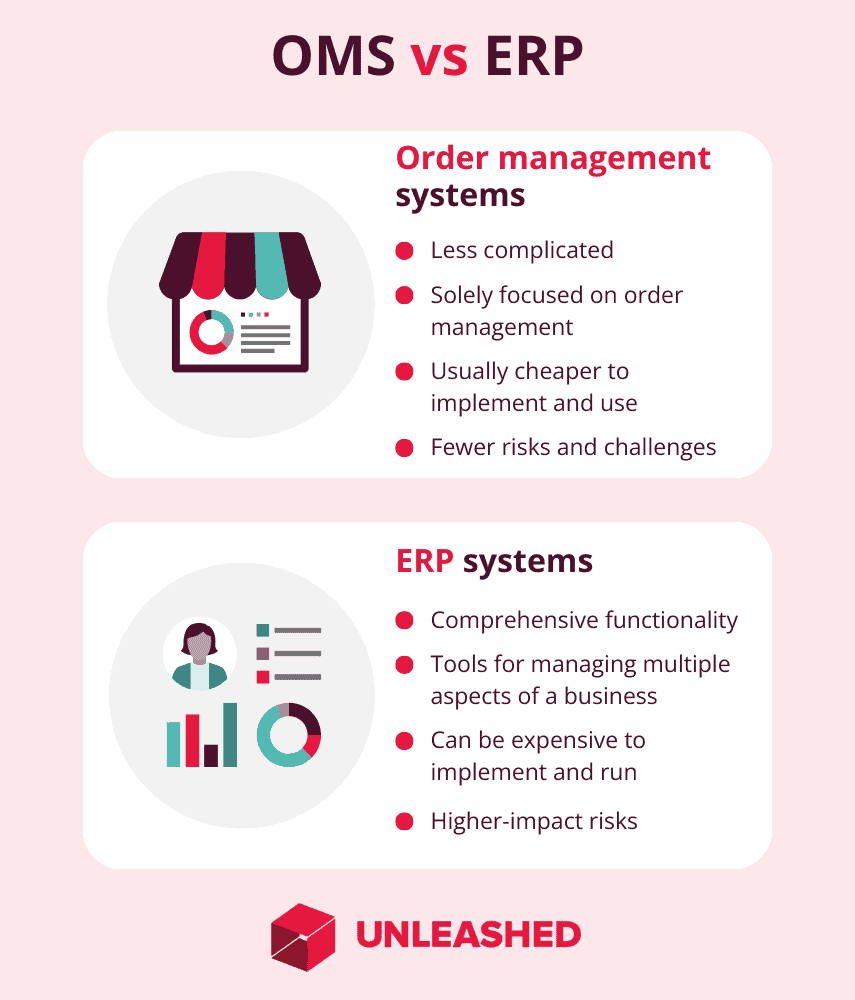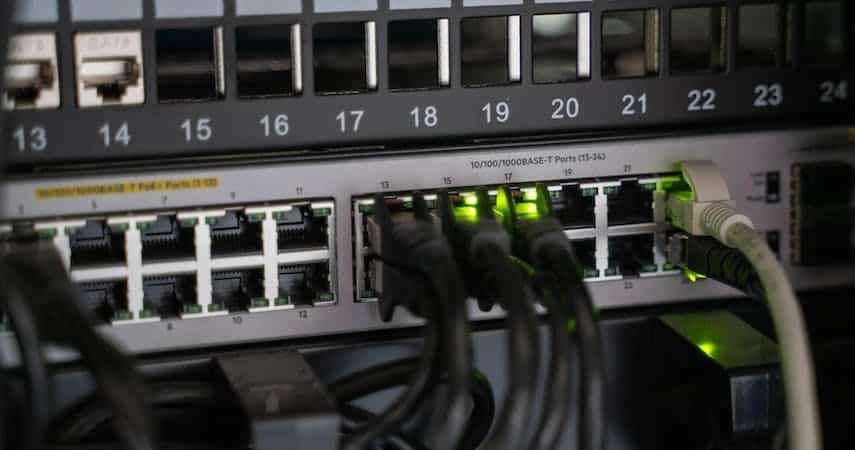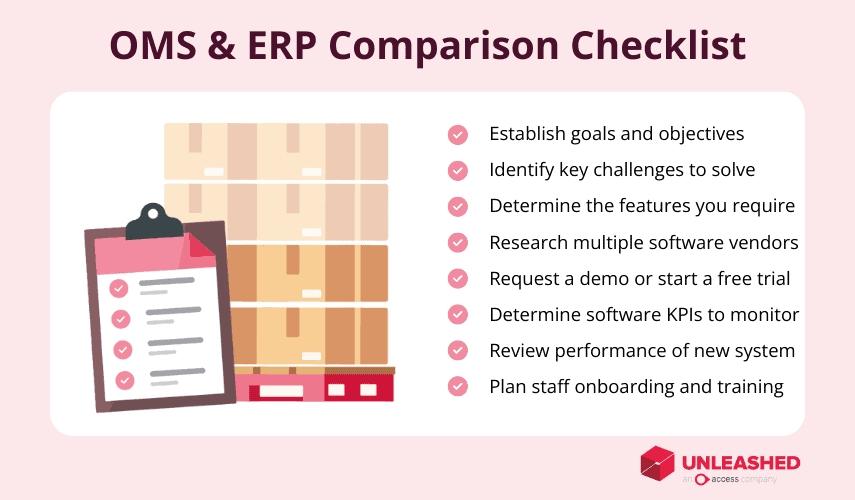
OMS and ERP systems both automate your workflows, collect and analyse data, and can be integrated with other business applications. So, when it comes to investing in supply chain software, how do you know which solution is best for you?
This article breaks down the key differences between OMS vs ERP. We’ll dive into the unique features and functionality – and explore which types of companies the two systems are best suited for to help you decide which is the right software for your business needs.
What is an OMS?
An order management system (OMS) is a software application that can run your entire order lifecycle – from inventory management and fulfilment to distributing order status notifications and managing any returns or exchange orders. It aims to streamline the order management process by automating manual tasks and providing real-time visibility across all your customer orders.
What is an ERP system?
An enterprise resource planning (ERP) system is a software solution that integrates and manages various parts of your business, such as sales, finance, marketing, planning, human resources, and procurement. An ERP is largely a back-office tool that integrates your various computer systems in near-real-time to provide a central view of essential financial, operational, and business data that can be shared across your organisation.
- Try for free: Cloud based ERP software for small business
What’s the difference between OMS vs ERP?
ERP systems integrate and manage several aspects of your business, such as accounting, finance, operations, and human resources activities. In contrast, an OMS is a software system that is primarily designed for managing orders.
OMS and ERP differ in both scope and purpose. An OMS is specifically more focused on the order management cycle, while an ERP’s focus is more general, covering a wide range of business functions.
An OMS is designed to oversee complex and dynamic order scenarios, such as multiple sales channels, inventory locations, delivery options, and customer preferences. An ERP system is designed to manage back-office processes, such as production scheduling, material planning, accounting, and reporting.

OMS vs ERP key differences:
- Scope and complexity: An OMS is a focused and specialised system that mainly deals with the order management process, whereas ERP is a more comprehensive and complex system that covers multiple aspects of business operations.
- Cost and implementation: OMS software is usually cheaper and easier to implement than ERP systems, as it requires less hardware, onboarding, and training. ERP is usually more expensive and time-consuming to implement than OMS because it involves more components, modules, and configuration.
- Benefits: Order management systems can help businesses improve order accuracy, efficiency, and customer satisfaction. ERP systems can help businesses streamline their operations, reduce costs, and enhance their decision-making.
- Challenges: OMS solutions pose challenges such as data security, scalability, and compatibility. ERP risks include implementation failure, poor data quality, and change management.
An OMS and an ERP can work together to optimise your business performance.
Your OMS can communicate with your ERP to access product information, inventory levels, customer data, and financial records. An ERP can receive order data from the OMS to update the accounting and reporting systems.
However, an OMS and an ERP are not interchangeable. An OMS will typically provide more flexibility, visibility, and efficiency for the order management cycle than that of an ERP system.
- Learn more: ERP vs MRP Systems – What's the Difference?
OMS vs ERP: Shared features and functions
OMS and ERP systems have similar features and functions, including:
- Data collection and analysis – OMS and ERP systems collect and store data from various sources, including sales, purchases, inventory, and customer information. They also provide dashboards for analysing and reporting data in the form of charts and graphs.
- Workflow automation – Both systems automate many tasks and processes involved in running your business. They generate invoices, send notifications, update records, and schedule activities.
- Integration and customisation – Effective OMS and ERP systems easily integrate with other software applications, including your eCommerce platforms, payment gateways, and shipping services. They are also customisable to suit the specific needs and preferences of individual businesses.
Integrating OMS and ERP systems: The hybrid approach
One of the usual questions that businesses face when deciding on their technology stack is whether they need an order management system, an enterprise resource planning system, or both.
The reality is that OMS and ERP have distinct roles and functions, and they can complement each other to provide a better customer experience and operational efficiency. An OMS can manage your entire order lifecycle, from the moment a customer places an order until the order is fulfilled or returned.
Order management systems can handle complex scenarios such as:
- Multiple sales channels
- Multiple shipping options
- Real-time inventory visibility
- Omnichannel order fulfilment
- Order modifications, returns and exchanges
- Customer communications
An OMS will optimise your fulfilment process by choosing the best source of inventory based on availability, cost, and customer preference.
An ERP system integrates and manages the various areas of your business, including finance, accounting, human resources, supply chain, manufacturing, and wholesale tasks and activities. ERP systems store and report on product information, customer information, order information, and shipping information.
However, an ERP system is not designed to manage the dynamic and customer-centric aspects of order management, such as real-time availability, customer promise, order orchestration, and post-order processing.
By integrating your OMS with an ERP system, you can enjoy time-saving data sharing and a complete end-to-end operations management system.
 Integrating separate business software systems doesn't require a nest of cables anymore – but it does require patience.
Integrating separate business software systems doesn't require a nest of cables anymore – but it does require patience.
Advantages of choosing an OMS vs ERP
Here are six benefits of choosing an OMS vs ERP for your business:
- An OMS can provide consistent and reliable availability across all channels based on real-time inventory data from multiple sources.
- Order management systems can calculate a specific fulfilment promise for each customer based on accurate availability, customer location, shipping options, and business rules.
- An OMS can coordinate the fulfilment of each order by selecting the optimal fulfilment point, communicating with shippers and carriers, tracking the order status, and updating the customer in real time.
- An OMS can manage customer orders throughout the order lifecycle by allowing customers or businesses to amend the order. For example, cancelling items, changing delivery addresses and dates, or initiating returns or exchanges.
- An OMS can improve customer satisfaction and loyalty by providing a seamless and flexible order experience that meets their expectations and preferences.
- OMS can reduce your operational costs and increase efficiency by optimising inventory use, reducing shipping costs, minimising errors, and delays, and automating your workflows.
An OMS is a specialist system that focuses on your order management, while an ERP is a broad system that covers numerous business functions. By choosing an OMS over an ERP for order management, your business benefits through improved customer experience and operational performance.
Risks of choosing an OMS vs ERP
Choosing an order management system over an enterprise resource planning system can have business risks. This is because an OMS will only manage your sales order processing and fulfilment functions, while an ERP integrates workflows from multiple departments within a company.
Potential risks of choosing OMS over an ERP include:
- A lack of data integration. Order management systems may lack the capability to communicate with your other business systems such as accounting software, inventory management software, or CRM. This can lead to data silos, errors, and inefficiencies in your business operations.
- Higher maintenance costs. Order management systems potentially need more updates, patches, and customisations compared to those of an ERP system. This can increase the complexity of the system and your maintenance costs.
- Reduced scalability. An OMS is less likely to manage the growth or expansion of your business, especially if the company operates in multiple locations, channels, or markets. In this scenario, an ERP system may offer more flexibility and functionality to support any growth or changes in your business.
ERP systems provide the ability to automate repeatable business tasks that order management systems typically don’t deal with, such as payroll, supplier management, HR, and manufacturing.
ERP vs OMS: Which is right for me?

When it comes to business software, there’s no one-size-fits-all answer.
For smaller companies, an ERP system may be too expensive or complex. For larger companies, an OMS may not provide the complete functionality required to be successful.
However, company size is not the only influential factor to consider.
Follow these steps to determine the best system for your business:
- Establish your business needs and objectives.
- Identify the main challenges you want the OMS or ERP system to solve.
- Determine the key features and functions that you need from the software.
- Research and compare different systems and providers to determine the advantages and disadvantages of each.
- Request a demo or take a free trial of the systems that interest you so you can ascertain the ease of use, flexibility, integration, and how responsive and helpful the customer support service is.
- Consider which order management metrics are required to measure the success and ROI of the system selected.
The choice you make will depend on the specific requirements of your business.
An ERP is a comprehensive system that integrates all aspects of your business, while an OMS manages how the availability of products is reliably and consistently displayed to end customers through whichever channel they choose to shop.
More factors to consider when comparing ERP vs OMS
When choosing an ERP or OMS, it’s important to consider the specific needs of your business. These include:
- Subscription costs: Subscription costs of ERP vs OMS vary depending on the features, functionality, and scalability of the software. ERP systems are generally more expensive because they cover a wider range of business processes and integrate with multiple data sources.
- Implementation costs: The implementation costs of both systems will depend on the size, scope, and complexity. However, ERP implementation costs are typically much higher and can hurt your bottom line. Costs include software licenses, partner fees, customisation, integration, training, and support.
- Risks: An ERP is a general back-office solution that can handle various functions, but it may not have the capability to manage complex order flows. An OMS can manage orders across multiple sources and provide real-time visibility and flexibility, but not be able to handle other business processes that are not related to order management.
- Ease-of-use: ERP systems are usually more complex and require more training and customisation to fit the specific needs of each business. Order management systems are simpler and more focused on the order management function, making them easier to use and implement. However, this also means that OMS systems may not have all the features and capabilities that ERP systems offer.
If your main concern is to manage orders and inventory with a strong focus on customer support, then an OMS may be the better fit. If you need a comprehensive system that integrates all aspects of your business, an ERP may be the better solution.
Who are ERP systems best for?
ERP systems are better suited to businesses that require a comprehensive system that integrates all aspects of the business. ERP systems can streamline your processes and reduce data silos, making them ideal for larger businesses that need to manage an expansive range of operations.
Choosing the right ERP system for your business will depend on the size of your business, the industry you operate in, your company’s goals, and your budget.
Below are some businesses that may benefit the most from implementing an ERP system.
Healthcare institutions
An ERP system can provide a more comprehensive and holistic view of a healthcare institution's operations, performance, and profitability. It may also help improve the efficiency, accuracy, and quality of healthcare services by reducing errors, duplication, and waste.
Construction companies
An ERP system helps construction companies streamline their workflows and optimise their operations. It automates tasks such as invoicing, purchasing, scheduling, and payroll, to reduce errors, save time, and increase productivity.
ERP systems help construction companies adapt to changing market conditions and customer demands. By providing real-time data and insights, ERP systems help you make informed decisions and adjust your construction strategies accordingly. ERP also supports scalability and growth by allowing you to add new modules and features as needed.
Manufacturing industries
Manufacturing industries benefit from implementing an ERP system because it can provide a comprehensive view of the entire business operation, improve efficiency and productivity, reduce costs and errors, and enhance customer satisfaction.
Wholesale industries
An ERP system is good for wholesalers because it helps streamline and optimise a range of business processes including inventory management, order fulfilment, customer service, and accounting.
Integrating data from various sources into an ERP system provides a unified and accurate view of business performance and operations, and enables better decision-making, demand forecasting, and planning to reduce costs and increase efficiency.
Retail industries
Retail companies benefit from using an ERP system because it helps to streamline retail inventory management, CRM, accounting, and human resources. The software integrates with other platforms – such as mobile apps, point-of-sale systems, and social media – to create a seamless and consistent customer experience across all channels.
 Order management systems are popular among smaller retailers, while larger enterprises may require the robust functionality of an ERP system.
Order management systems are popular among smaller retailers, while larger enterprises may require the robust functionality of an ERP system.
Who are order management systems best for?
Order management systems are suited to industries that deal with high volumes of orders, complex workflows, multiple channels, and diverse customer needs. They’re ideal for businesses that sell products or services online, such as eCommerce, retail, wholesale, or subscription-based businesses.
An OMS can help companies like these to improve customer satisfaction, reduce operational costs, increase efficiency, and optimise inventory levels.
For eCommerce, an OMS will integrate different channels and platforms involved in online sales, such as shopping carts, payment gateways, warehouses, shipping providers, and CRM tools. Popular eCommerce order management systems include Shopify, Salesforce, and WooCommerce.
For companies operating on multiple sales channels, an omnichannel order management solution like Unleashed can help you bring all your data together under one roof for more efficient inventory and order management. Get started for free today with a 14-day trial.
To choose the right OMS for your business, you should consider the needs of the business, your budget, integration options, scalability, and customer support.
